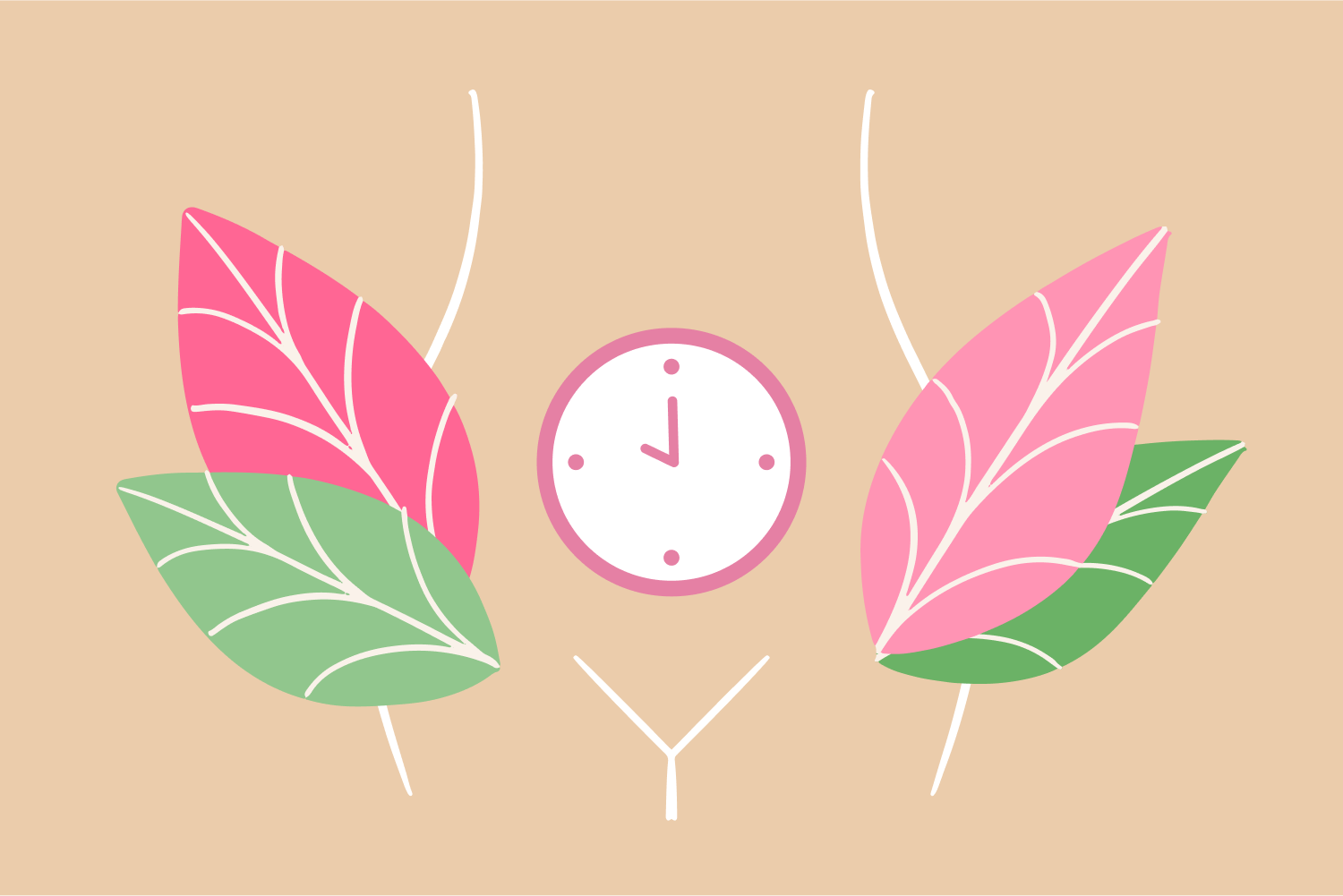Ovulation 101: What Is Ovulation and When Do You Ovulate?

Every menstrual cycle has two milestones: a period and ovulation. Keeping track of the timing of both of these events not only helps you plan a pregnancy, but it can also help you avoid pregnancy as well.
In this article, we will be focusing specifically on ovulation. We’ll cover what it is, how it works, and when it occurs. We’ll also shed light on some of the most common symptoms of ovulation, how you can keep track of when you ovulate, and what you can do with this information whether you are TTC or TTA a pregnancy.
What is ovulation?
Ovulation is a reoccurring event where an egg is released from the ovaries. The process involves the egg traveling down the fallopian tube and making its way towards the uterus. Women are considered at “peak” fertility in the days leading up to ovulation and on the day of ovulation.
When do you ovulate?
Ovulation typically occurs midway through each cycle.
You may have read that ovulation occurs on day 14 (which is two weeks before the onset of your next period). However, this is more of a myth than a truth. This assumption is based on an average cycle length of 28 days, and it does not account for cycle to cycle variability.
The reality is that every woman and every cycle is unique, and it’s considered normal to ovulate anytime between days 6 to 21 of your cycle.
It is also possible to ovulate multiple times per cycle, though this is a rare occurance.
Understanding ovulation
How does ovulation work?
To explain how ovulation works, let’s start with the beginning – i.e. day 1 of your menstrual cycle.
The first day of your period is considered the first day of your cycle, with the last day of your cycle being the day before your period starts again. The cycle can then be broken up into two phases: the follicular phase and the luteal phase.
At the beginning of the follicular phase, the follicle stimulating hormone (FSH) rises. This hormone helps to develop an ovarian follicle, which will eventually house an egg. FSH also helps to initiate the production of estrogen, which supports the further development of the follicle and egg, while also thickening the uterine lining.
Next, luteinizing hormone (LH) surges and triggers the body to ovulate. The process of ovulation involves the egg being released from the follicle and traveling down the fallopian tube towards the uterus.
During this time, the egg can be fertilized by a sperm and result in pregnancy. If the egg is not fertilized, the uterine lining will shed together with the unfertilized egg during menstruation. This time frame after ovulation but before your period is known as the luteal phase.
What are the most common ovulation symptoms?
There are a few key biological markers or “symptoms” of ovulation. The most common include:
- Changes in cervical mucus. For example, you may notice that your discharge resembles the look and texture of raw egg whites around the time of ovulation.
- Changes in the positioning of the cervix. For example, it is common for the cervix to move higher up in the body around ovulation, while also becoming softer and more moist than normal.
- Changes in basal body temperature (BBT). For example, your BBT drops prior to ovulation, and then it quickly increases up to 0.5-1 degrees Fahrenheit (0.3-0.6 degrees Celsius) after ovulation.
- Pain and cramping. Ovulation pain, commonly referred to as “mittelschmerz”, is a symptom that approximately one in five women experience. This pain can occur around ovulation and often feels like sharp pain or pressure in the lower abdomen.
- Increased libido. It’s common to experience an increase in libido around your time of ovulation. This is simply nature’s way of saying that it’s the right time to try to conceive.
Another symptom of ovulation is elevated LH levels, which you can measure with a hormone tracker like Mira, an ovulation test kit, or at your doctor’s office with a blood test.
How long does ovulation last?
The entire process surrounding ovulation including the LH surge is approximately 24-36 hours. However, this time frame can vary among women, and can even vary from cycle to cycle.
How do you know when ovulation is over?
If you know the signs of ovulation, you’ll find it easy to figure out when ovulation is over!
For example, you may notice that your cervical mucus is lighter and returns back to a thick or creamy consistency. The cervix may also feel harder, compared to its softer texture during ovulation. If you track your BBT, you will quickly notice that your temperature increases in the short term after ovulation. Another thing to pay attention to is your sex drive, as it’s common to experience decreased libido following ovulation and during the luteal phase.
Another sign that ovulation is over is heightened progesterone levels, which can be measured with Mira’s confirm wands or at your doctor’s office with a blood test.
How can you track ovulation?
There are several different ways that you can track and predict ovulation – which is useful whether you are TTC or TTA pregnancy.
One of the most basic ways to track ovulation is by following the Calendar Method. This method uses a mathematical formula to estimate your day of ovulation based on your cycle length and the first day of your last period.
Another method that you can try is the Basal Body Temperature (BBT) Method. With this method, you must take your temperature at the same time each day (usually in the morning). Over time, you will be able to spot the sudden rise in temperature around ovulation, and potentially predict when it will rise in the next cycle.
The Cervical Mucus Method is another method for predicting ovulation. All you have to do is track the color, texture, and consistency of your mucus each day and document it in an app or a diary. After several months of tracking, you can easily identify when your mucus is the most “fertile”, which will be around the time of ovulation.
One of the most accurate ways to track and predict ovulation is by tracking your hormones directly. This can be done with an at-home hormone tracking system like the Mira.
With Mira, you can track key hormone levels like estrogen (E3G), LH, progesterone (PdG), and FSH in a simple and non-invasive way. You can get precise daily hormone level readings, similar to those from a lab, and monitor your hormonal map over time through dynamic charts on your smartphone – clearly pinpointing your ovulation patterns.

How to prepare for ovulation
Ovulation if you’re TTC
So you know that you’ll be ovulating soon, but when exactly should you have sex in order to maximize your chances of getting pregnant?
Ideally, you should try to have sex with your partner on your day of ovulation, as this is when you are considered at “peak” fertility. However, because the exact timing of ovulation can be difficult to pinpoint, doctors recommend simply having sex daily around the time that you anticipate ovulation will occur. This period of time is known as your fertile window, and it includes the four to five days leading up to ovulation, the day of ovulation, and one day after ovulation.
Technically speaking, your highest chances of conceiving are on the day before ovulation and the day of ovulation. However, it’s still possible to get pregnant during any day of your fertile window. Outside of your fertile window, your chances of getting pregnant are very low.
Ovulation if you’re TTA
If you are tracking ovulation in order to avoid getting pregnant, it is important that you abstain from intercourse completely during your fertile window. Again, this fertile window includes the four to five days leading up to ovulation, the day of ovulation, and the day after ovulation. Many women also add a few buffer days before and after their fertile window. This helps to account for any miscalculations or irregularities in their cycle.
You may be tempted to use condoms or other prevention methods during this time. However, bear in mind that these methods are not 100% effective at preventing pregnancy. The only surefire way to avoid pregnancy altogether is by not having sex with your partner during your fertile window.
Ovulation FAQs
How long after ovulation pain is the egg released?
Because ovulation pain or “mittelschmerz” is uncommon, there is limited research on the specific timings of when the pain is felt and when exactly ovulation occurs. However, one study observed that among patients with mittelschmerz, the majority experienced ovulation pain during the LH surge. This means that the egg would be released approximately 24-36 hours after experiencing ovulation pain.
It’s important to note though that experiences of mittelschmerz can vary greatly among women. The best way to predict any patterns for ovulation pain and ovulation for yourself is by tracking your individual symptoms over time.
How many days after your period do you ovulate?
Everyone’s cycle and ovulation patterns are unique. However, a good rule of thumb is to assume that ovulation occurs midway through your cycle.
That means that if your cycle length is 28 days, then you will likely ovulate around day 14. If your cycle is longer than 28 days, you may ovulate later than day 14. And if your cycle is shorter than 28 days, you may begin ovulation before day 14. On average, it’s considered “usual” for ovulation to occur between days 6 to 21.
It’s important to note here that individual cycles can even vary in length throughout an individual’s lifetime. Things like diet, exercise, stress, illness, and drug use can all have an impact on the timings of your period and ovulation. That’s why it’s important to try to stay in tune with your body, track your symptoms, and accept that ovulation may not always occur on the same day of your cycle.
Is ovulation the same as your period?
No. Ovulation and your period are not the same thing.
Ovulation is when your ovaries release an egg that has been developing during the first half of your cycle. Once released, this egg travels down your fallopian tube and is available to be fertilized by a sperm (which results in pregnancy). Thanks to the hormones estrogen and progesterone, your uterine lining has been thickened, strengthened, and prepared to accept a fertilized egg for implantation.
If your egg is not fertilized, your uterine lining breaks down and is shed through your vagina. This process is your period and marks the beginning of your cycle.
Mira’s Editorial Process
All content produced by Mira meets stringent editorial standards, ensuring excellence and accuracy in language and medical precision. Every piece undergoes thorough fact-checking and review by qualified professionals. Check out our full editorial process to learn more.










